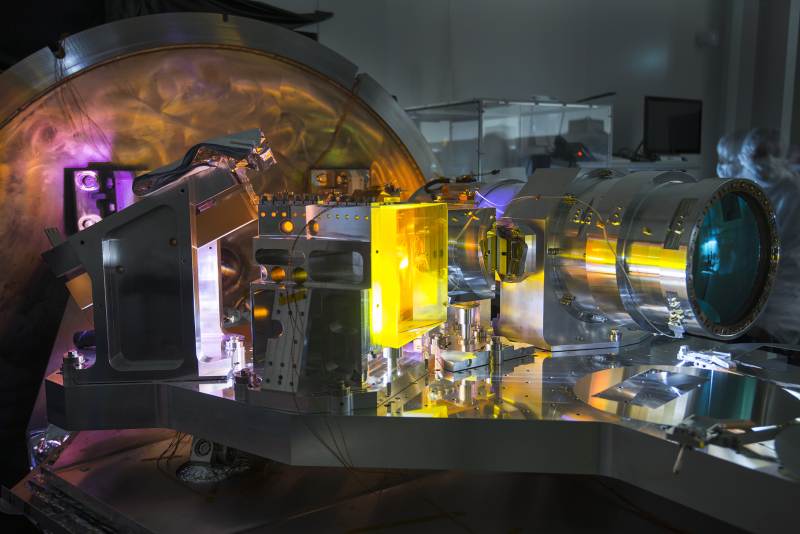Watch out for changing stellar magnetic fields
The 11-year solar activity cycle is a well-known phenomenon, during which the intensity of the Sun’s magnetic field varies and its polarities reverse. Over the past 30 years, astronomers have identified similar behavior in several Sun-like stars. But until now, no reversal of magnetic polarities has been observed for their cooler counterparts, the red dwarf stars.
Now, an international team including scientists from the CNRS ( including IRAP) has shown that the magnetic field of the extremely active red dwarf AD Leonis may be approaching polar reversal. These data were obtained using the ESPaDOnS (1) and SPIRou (2) instruments at the Canada-France-Hawaii Telescope (CFHT), and NARVAL (3) at the Bernard Lyot Telescope (BLT).
AD Leonis is a notoriously active red dwarf star, with a magnetic field around 1000 times stronger than that of the Sun. Although evidence of activity cycles exists, it is not yet known whether red dwarfs can exhibit magnetic cycles.
AD Leonis has been observed since 2006 with the ESPaDOnS and NARVAL instruments, and since 2019 with SPIRou. The study, led by IRAP PhD student Stefano Bellotti, shows that not only does the magnetic field intensity decrease continuously over this period, but also that the star’s magnetic poles have begun to flip. Although polarities were not reversed during the SPIRou observations, these results indicate that red dwarfs like AD Leonis may undergo magnetic cycles, like the Sun.

This result provides a better understanding of the magnetic field generation of stars colder than the Sun. Furthermore, the study of the magnetic field of red dwarfs – prime targets for the detection of rocky, Earth-like exoplanets – is essential for understanding the space environment in which rocky exoplanets orbit.
Notes
- The ESPaDOnS new-generation stellar spectropolarimeter is a project funded by a partnership between France (CNRS/INSU, Ministère de la Recherche, LATT – Observatoire Midi Pyrénées, Laboratoire d’Etudes Spatiales et d’Instrumentation en Astrophysique – Observatoire de Paris), Canada (NSERC), the Canada-France-Hawaii Telescope and ESA (ESTEC/RSSD).
- SPIRou is a high-precision spectropolarimeter and velocimeter operating in the near-IR range (0.98-2.35µm). SPIRou is an international project, managed by a consortium spread over France, Canada, Switzerland, Taiwan, Portugal, Brazil and Hawaii. On the French side, 4 laboratories are technically involved: IRAP (Toulouse), IPAG (Grenoble), OHP/LAM (Marseille) and LESIA (Meudon).
- Like its twin ESPaDOnS, NARVAL is a stellar spectropolarimeter developed at the Observatoire Midi-Pyrénées (OMP – CNES/CNRS/Météo France/IRD/UT3 Paul Sabatier), by scientific and technical teams from the Institut de recherche en astrophysique et planétologie (IRAP/OMP – CNRS / CNES / UT3 Paul Sabatier), the Télescope Bernard Lyot (TBL) and OMP’s shared services.
CNRS laboratories involved
- Institut de recherche en astrophysique et planétologie (IRAP – OMP). Tutelles : CNRS / CNES / Université Toulouse 3
- Institut de planétologie et d’astrophysique de Grenoble (IPAG – OSUG). Tutelles : CNRS / Université de Grenoble
- Institut d’astrophysique de Paris (IAP). Tutelles : CNRS / Sorbonne Université
- Laboratoire d’astrophysique de Marseille (LAM – OSU Pytheas). Tutelles : CNRS / CNES / Aix Marseille Université
Further resource
- Scientific paper : Belloti S. et al. Monitoring the large-scale magnetic field of AD Leo with SPIRou, ESPaDOnS, and Narval, Astronomy & Astrophysics, 676, A56,
IRAP Contact
- Pascal Petit, pascal.petit@irap.omp.eu






